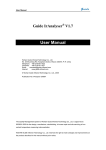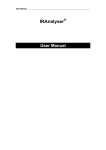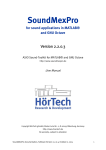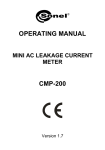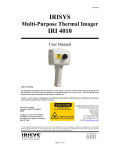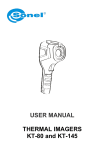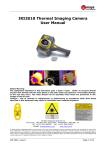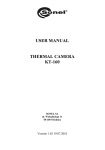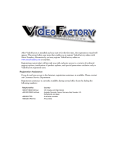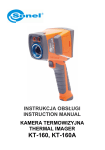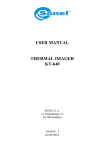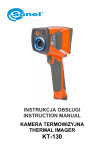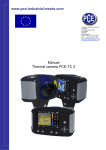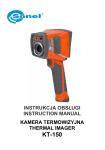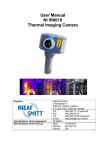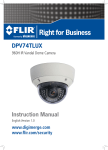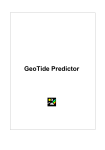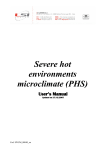Download User Manuals
Transcript
Sonel ThermoAnalyze® USER MANUAL v 1.04.1 12.03.2011 The Quality Management System ISO9001:2008 is approved for the design, manufacture and maintenance of all the measuring instrumentation manufactured by Sonel S.A. Due to a policy of continuous development of our products, Sonel S.A. reserves the right to make changes and improvements on the Thermal Imager and the Thermo Analyze software described in this manual without prior notice. Copyright © Sonel S.A., 2010. All rights reserved. This manual must not, in whole or part, be reproduced, transmitted or translated into any language in any form or by any means, electronic, magnetic, optical, manual or otherwise, without the prior written permission of Sonel S.A. 2 Sonel ThermoAnalyze® TABLE OF CONTENT 1 INTRODUCTION ....................................................................................................5 2 INSTALLING SONEL THERMOANALYZE ......................................................6 3 USING SONEL THERMOANALYZE.................................................................11 3.1 CHOOSING A LANGUAGE FOR SONEL THERMOANALYZE .........................................11 GET TO KNOW SONEL THERMOANALYZE INTERFACE .............................................11 3.2 Menu Bar .....................................................................................................11 3.2.1 Toolbar ........................................................................................................12 3.2.2 Palette Bar ...................................................................................................12 3.2.3 Information Bar ...........................................................................................12 3.2.4 DataView Bar ..............................................................................................13 3.2.5 Gauge Bar ...................................................................................................14 3.2.6 Status Bar ....................................................................................................14 3.2.7 USE COMMANDS UNDER MENU BAR .....................................................................15 3.3 File Menu .....................................................................................................15 3.3.1 Image Menu .................................................................................................17 3.3.2 “Filter” Menu ..............................................................................................21 3.3.3 “Measure” Menu .........................................................................................23 3.3.4 Tools Menu ..................................................................................................39 3.3.5 View Menu ...................................................................................................47 3.3.6 Window Menu ..............................................................................................49 3.3.7 4 INFRARED VIDEO ...............................................................................................51 4.1 GENERAL INFORMATION.......................................................................................51 MAIN MENU.........................................................................................................51 4.2 VIDEO MODE MENU .............................................................................................55 4.3 Video Menu ..................................................................................................55 4.3.1 Measure Menu .............................................................................................58 4.3.2 Tools Menu ..................................................................................................60 4.3.3 View Menu, Window Menu, Help Menu ......................................................66 4.3.4 5 CREATING REPORT WITH MICROSOFT® WORD ......................................67 5.1 USING THE MENU .................................................................................................67 File menu .....................................................................................................67 5.1.1 Report Menu ................................................................................................68 5.1.2 Window Menu ..............................................................................................70 5.1.3 Help Menu ...................................................................................................71 5.1.4 Toolbar description .....................................................................................71 5.1.5 USER MANUAL 3 5.2 CREATING A REPORT ........................................................................................... 71 CREATING AN INSPECTION REPORT WITH THE REPORT WIZARD ............................ 72 5.3 Creating a Report........................................................................................ 72 5.3.1 Creating Report based on a Customized Report Template ......................... 75 5.3.2 6 EMISSIVITY ......................................................................................................... 78 6.1 4 TYPICAL EMISSIVITY VALUES................................................................................ 80 Sonel ThermoAnalyze® 1 Introduction This publication provides the necessary information required to use the PC software Sonel ThermoAnalyze ® to analyze static image files or real-time video taken by thermal camera of SONEL S.A. It is recommended that this user manual and the thermal camera’s user manual are read thoroughly before using the software. It is also advisable that all user manuals and instruction leaflets supplied are kept readily available for reference, when the software is in general use. Technical Support Technical support for the software can be obtained on weekdays, from 7 a.m. to 3 p.m., by either contacting the telephone number +48 74 8583860, or by email to the following address: [email protected] Feedback to Us From our side we guarantee to make every effort to ensure proper operation of the equipment and the software. In case of any changes, related to continuous development of our products, information on the changes will be available on our website www.en.sonel.pl. Additionally, you are appreciated to let us know about any error you find, and your suggestions for further editions by writing an email to the following address: [email protected]. USER MANUAL 5 2 Installing Sonel ThermoAnalyze System requirements Operating system: Window 2000 or higher (Windows2000, WindowsXP, WindowsVista), Internet Explorer 5.0 (or higher) ® ® ® Software: Microsoft Office 2000 or higher ( Microsoft Office 2000, Microsoft Office XP, ® ® Microsoft Office 2003, Microsoft Office 2007 Minimum hardware requirement: Processor Pentium3 1GHz RAM 256MB (512MB recommended) Free available space on hard disk drive 100MB Display Super VGA (800 x 600) or higher; or higher resolution monitor with 16-bit colors It is recommended that you close down all applications before installing the program. Driver Installation Guide It is recommended to install driver before connecting thermal camera to PC. After inserting the CD containing the driver (supplied with your camera) into CD-ROM drive, installation dialog box will appear. If the installation box doesn’t appear automatically, doubleclick “autorun.exe” file in the CD’s main folder. After selecting language new dialog box will appear. Choose “thermal cameras” and then “install driver”: 6 Sonel ThermoAnalyze® Choose the type of driver, depending on the operating system installed on your computer (32 or 64 bit) If the camera was connected to your computer before installing the driver, or the original installation CD is missing, you can perform installation process manually, using previously obtained driver (e.g. by downloading it form our website www.en.sonel.pl). After connecting the camera to USB port in your computer, new Sonel IR device Installer will appear. Installer will ask you whether to search for new driver online or not, you need to select “no, not this time” option and click “next”. Then allow searching for the drivers automatically – the installer will search for the drivers through all data carriers: USER MANUAL 7 If the driver is not found automatically choose “Install from a list or specific location (advanced)” Next use the browser to point the folder (drive) containing driver file, and click next to proceed Installation begins. After reaching the stage shown below, choose „ continue anyway”: 8 Sonel ThermoAnalyze® Dialog box will inform you that the installation process is finished. Click “finish” button. Sonel ThermoAnalyze Install Guide It is recommended to close down all applications before installing the program. After inserting the CD containing the software (supplied with your camera) into CD-ROM drive, installation dialog box will appear. If the installation box doesn’t appear automatically, double-click “autorun.exe” file in the CD’s main folder. After selecting language new dialog box will appear. Choose “thermal cameras” and then “install ThermoAnalyze”: Installation process will begin, follow the on-screen instructions. NOTE: Without changing the default directory to install the program, the installation procedure will allow the program to be installed under C: \Program files\ Sonel ThermoAnalyze. The installation procedure will add a shortcut icon Launch Sonel ThermoAnalyze to the Desktop and Start menu. USER MANUAL 9 Uninstall Sonel ThermoAnalyze Proceed similarly as in the case of installation; after dialog box appears choose “remove…” option. 10 Sonel ThermoAnalyze® 3 Using Sonel ThermoAnalyze 3.1 Choosing a language for Sonel ThermoAnalyze After you install the program in your PC and run the program, the program will open with the default language. The default language is usually the one used by your operating system. To change the language, go to Language command under View menu and then choose a language you need. A checkmark √ will appear in front of the selected language. After choosing the language, the program will prompt you to restart it or keep the program running with the previously selected language. In order to confirm the language you need to restart the program. 3.2 Get to know Sonel ThermoAnalyze interface The program has only one Windows-based interface. After starting the program, the program interface below will appear. It consists of seven parts: Menu bar, Toolbar, Palette bar, Information bar, DataView bar, Gauge bar and Status bar. Below please find detailed introduction to each part. 3.2.1 Menu Bar Menu bar consists of eight sub-menu options, including File, Image, Filter, Measure, Tools, View, Window and Help. Keep left button of the mouse pressed and moving the mouse will allow you to move the menu bar to any desired place. USER MANUAL 11 Note: Number of sub-menu options depends on the current mode (Thermogram, IR video, Report). 3.2.2 Toolbar The toolbar is displayed across the top of the program window, below the menu bar. The toolbar provides quick one-click mouse access to major functions in the program: Keep the left button of mouse pressed over the left edge of the toolbar and moving the mouse will allow you to move the toolbar to any place. Note: To hide or display the toolbar, click Toolbar in the View menu. 3.2.3 Palette Bar There are nine palettes available. Moving the mouse across them will accordingly change colors of the current opened image file and gauge color. Clicking on a certain palette to confirm the selection. Move the mouse out of them without clicking a certain one, the opened image file will still be in the original color. Keep left mouse button pressed and moving the mouse will allow you to move the palette bar to any desired place. Note: To hide or display the palette bar, click Palette Bar in the View menu or click the shortcut in the toolbar of View menu 3.2.4 Information Bar Display information of the opened image file, such as emissivity, humidity, date and time when it was created. While moving the mouse within the image file, coordinates and temperature of the image pixel where the mouse lies will be displayed in the Information bar. 12 Sonel ThermoAnalyze® Note: - To display or hide the information bar, click the Information Bar in the View menu. Clicking well. on the right top of the information bar can hide Information Bar as 3.2.5 DataView Bar Display temperature measurement result of analyzed objects (spots, lines, circles, rectangles, polygons, or delta-two spots) added to the opened image file if any. Keep left mouse button pressed and moving the mouse will allow you to move the DataView bar to any desired place. USER MANUAL 13 Note: - To display or hide the DataView bar, click DataView Bar in the View menu. Clicking well. on the right top of the DataView bar can hide the DataView bar as 3.2.6 Gauge Bar It displays different colors according the different temperature. Note: To hide or display the gauge bar, click Gauge Bar in the View menu. 3.2.7 Status Bar The status bar is displayed at the bottom of the program window. The left area of the status bar describes actions of menu items as you use the up and down arrow keys to navigate through menus. This area similarly shows messages that describe the actions of toolbar buttons as you press them, before releasing them. If after viewing the description of the toolbar button command you wish not to execute the command, then release the mouse button while the mouse pointer is off the toolbar button. Note: To display or hide the status bar, use the Status Bar command in the View menu. 14 Sonel ThermoAnalyze® 3.3 Use Commands under Menu Bar 3.3.1 File Menu Open Command Use this command to open an existing infrared image file in a new window. You can open multiple image files at one time. Switching active window is done by mouse click over the window or by using “window” menu. Note: - Clicking shortcut in the toolbar will open an existing image file as well. 12 images can be opened at a time File name is displayed on the title bar of the opened image file window. Save Command Use this command to save an opened image file along with all analysis elements added during analysis process. Note: - If the opened image file is in IMG format, a prompt whether to save it into IRI format will appear before saving it. - You have to save the IMG file as IRI format, then the analysis result can be saved into the file together. The analysis information can’t be saved in IMG image files - If the opened image file is in JPG format, the analysis result and the JPG file will be saved together in JPG format. - Clicking shortcut in the toolbar will save opened image file as well. Save Image as Command Use this command to save the opened image file with pallet or without pallet in JPEG or BMP image file. Note: You cannot measure temperature of pixels in the re-saved BMP or JPG image files To save the visual image of the current infrared image, please select the visual image firstly and then click the right mouse button, a menu of “Copy, Save as, Close” will appear. Selecting “ Copy” will copy the visual picture to other document, Selecting “ Save as” will save the visual picture as another BMP or JPG file, Selecting “ Close” will close the visual picture Close Command Use this command to close opened image file without saving. Setup Command Use this command to set a directory on the hard disks to store infrared images, reports, report templates and time format displayed in the information bar. USER MANUAL 15 After saving the setup, the program will automatically go to the directory when opening infrared images or reports and when creating reports using the Report Wizard. Report Command This command includes following sub-commands: “Word”, “Excel” and “Freport”” “Word” includes three sub-commands as follows: ® New: Use this command to create a Microsoft Word (program overlay – you must have ® Microsoft Word installed on your computer) report with the program for the currently opened image file; ® Open: Use this command to open an existing Microsoft Excel report ® Report Wizard: Use this command to create a Microsoft Word report step-by-step for the currently opened image file “Excel” includes two sub-commands as follows: ® New: Use this command to create a Microsoft Excel (program overlay – you must have ® Microsoft Excel installed on your computer) report with the program for the currently opened image file; ® Open: Use this command to open an existing Microsoft Excel report Freport: Use this command to create a report using internal file format. Note: The command “Report wizard” is only available after opening at least one infrared image file. External Device Manager command Using this command can delete image files saved in KT-160 or download them from the camera to your PC. If the camera's USB driver (can be found on the supplied CD) is installed on your computer, choosing this command will open a window allowing you to copy thermal images stored in the internal memory of the camera to your hard disk drive, or delete all files from the memory. To make this command active, the camera must be set to internal memory (Uflash), or the external memory card must be extracted. The camera must be switched on before running the software. 16 Sonel ThermoAnalyze® Get file from……to: Appoint the file range as per file numbers which will be transferred to PC.PC store directory: Appoint store directory for the files to be saved. Click Read button to transfer files to PC. Clicking Delete ALL button will remove all the image files from the built-in flash memory of the camera. Click Close button to exit the window. Note: Transferring files via USB can take several minutes. Exit Command Use this command to end your Sonel ThermoAnalyze session. After choosing this command, the program will prompt you to save changes made to opened image files. 3.3.2 Image Menu „Palette” command Use this command to choose a palette from the nine available for the opened infrared image file. Note: this function is also available in previously described Pallete Bar window „Rotate” command This command includes two sub-commands: 90 CW: 90 degree clockwise rotation of the opened image : 90 CCW : 90 degree counterclockwise rotation of the opened image : USER MANUAL 17 “Mirror” command This command includes two sub-commands: ”horizontal”: Use this command to get horizontally mirrored image of the opened image: “vertical”: Use this command to get vertically mirrored image of the opened image: “Zoom” command This command includes eight sub-commands: 50%: zoom out opened image by half its original size. 100%: restore the original size of the image. 150%: zoom in opened image to150% of its original size. 200%: zoom in opened image to 200% of its original size. 300%: zoom in opened image to 300% of its original size. 400%: zoom in opened image to 400% of its original size. 500%: zoom in opened image to 500% of its original size. Custom: self-defined zoom coefficient “Zoom In” command Zoom in opened image sequentially to: 100%→150%→200%→300%→400%→500%......→1000% This function is also available by pressing “Zoom out” command Zoom out opened image sequentially to: 18 button on toolbar menu Sonel ThermoAnalyze® 1000%→900%→800%.......150%→100%→50% This function is also available by pressing button on toolbar menu “Hand” command Allows to move the visible part of the image within the window. Press the left mouse button, while having the cursor over the image and move the mouse while keeping the mouse button pressed. “Actual Size” command Resume the original size of the image “Gauge setting” command Switch on/off the possibility of graphical representation of temperature for every infrared image. After switching it on, temperature range bar will pop-up, as shown below: The red line below colorful bar shows the temperature range registered in the infrared image. By moving the two slides we define the temperature range that will be represented by the colors displayed on the bar. By pressing “Auto” button, you can also use auto mode,. Press “Cancel” to restore original settings and to get back to manual mode. Note: You can also switch on/of the temperature range bar by double clicking on infrared image. When the gauge scale is adjusted, you can not change the palette. “Image Fusion” mode Set the infrared image and visual image in fusion After selecting Image Fusion option, you can decrease transparency of the infrared image by moving the slide from VL to IR position. USER MANUAL 19 The size and position of the thermal image in relation to the visual image can be adjusted by grabbing and dragging (holding down the cursor) thermal image window by using the "Zoom +" and "Zoom -" buttons. Rotate Angle command allows you to rotate thermal image if needed. In Fusion Mode you can lay infrared image over visual image only for the specified temperature range. You can adjust this range with "Low - High" slider, as shown on the image below Gauge Advance Setting Command This command establishes a mapping function for temperature and brightness of each image file. Type in the max and min temperature in the dialog box, or set the temperatures by pressing arrow buttons, to define the temperature range, as shown on the image below: If multi images are opened, Selecting Apply to all image will apply the temperature setting to all opened image files. The command is useful if user wants to compare similar thermal 20 Sonel ThermoAnalyze® images. User just sets a temperature range and applies to all the images, then, the difference between each image is easily found. “Play Sound” Command Use this command to play voice annotation saved with the opened image file if any. Note: - This command is only available for files with voice annotation stored. - Clicking shortcut in the toolbar will activate this command as well. The shortcut is only available for files with voice annotation stored. Property Command This command allows to display and change properties of the opened image file. Click OK button to save changes. Note: - Filter: It reflects camera lens if additional lens is used. - Emissivity: It reflects emissivity coefficient value that was set in the infrared camera while taking infrared pictures. If you change it here, the image temperature will also be changed. When adjusting emissivity coefficient value you must also remember to set proper background (ambient) temperature value. 3.3.3 “Filter” Menu A set of commands allowing to process thermal image: Blur: USER MANUAL 21 Emboss: Gaussian: Soften: Sharpen: Edge: Median: Add noise: 22 Sonel ThermoAnalyze® Erode: Dilate: Contour: Jitter: 3.3.4 “Measure” Menu “Temp Unit” mode Choose Celsius degrees or Fahrenheit degrees for temperature reading of the opened image file. You can switch between these units at any time. All the image temperature readings will change accordingly to selected units. “Show Max/Min Temp Pos” mode Indicates where the pixel with the Max /Min temperature lies in the opened image file. After selecting this command, Min/Max symbol will show up on the image, pointing the spot of the highest (lowest) temperature. USER MANUAL 23 Note: Max/Min Temp point along with temperature value will be displayed on the image automatically when you open the image. Choose this command again to delete the Max/Min Temp point from the image. “Show Profile” Command Use this command to display temperature profile along a line, added to the opened image file by user. When moving the mouse along the line, a vertical line will appear and move together with the mouse, showing temperature of the point where the vertical line intersects the user-defined line. This allows you to find any particular temperature located on the thermal image, which is read precisely from the profile. Icon + will show corresponding point on the line. Click the right mouse button on the line profile to view a window which brings up four commands: Copy, Setting, Save as, and Close. Choosing Copy command allows you to copy the rectangular coordinates and lines profiles to other applications. Choosing Setting command enables you to bring up the setup dialog box and change colors and the background of the rectangular coordinates if you wish. Click OK Button to save changes and Cancel button to close without saving changes. 24 Sonel ThermoAnalyze® Save As command will allow you to save the profile to BMP or JPG image file. Clicking Close button will close the profile view window. Note: - Temperature reading and unit of the coordinates will change along with your choice of temperature degrees. - Clicking short button in the toolbar can activate this command as well. „Isotherm” Command Use this command to add an isotherm to the opened image file for analysis. Temperatures from the chosen range will be displaying additional, selected color. Isotherm settings dialog box will appear after choosing this command. Clicking Button brings up the default isotherm. User can change its color, and limits by moving the scale pointers. Clicking Button again and repeating the above will add new isotherms and make changes to them as per requirements. Then pixels of the image file within the isotherm ranges are displayed in the isotherm colors. Choosing an isotherm button will delete the isotherm. name and clicking „Histogram” Command This command includes two sub-commands as follows: Image Histogram - Use this command to display the percentage temperature distribution histogram of the opened image file. Other Histogram: Use this command to display the percentage temperature disUSER MANUAL 25 tribution histogram of the selected part of the thermal image - a line, polygon line, rectangle, circle or polygon (if any). Image Histogram - After choosing this command, a dialog box showing the percentage temperature distribution histogram, divided into many ranges will appear: Moving the mouse cursor within rectangular coordinates of each histogram will display information on what is the percentage of the area that shares the selected temperature range in relation to the whole thermal image area. Clicking the right mouse button on histogram will bring up four commands window. Choosing Copy command allows you to copy the rectangular coordinates and the histogram to other applications. Choosing Setting command enables you to bring up the setup dialog box and change colors and background of the histogram. Choosing Save As command allows you to save histogram as BMP or JPG file. Close command will close the dialog box. Other histogram – This command is available after adding object to thermal image (line, rectangle, circle or polygon). After adding an object to the opened image file, choosing this command will open a dialog box showing the object’s name and type. Click on the object, and then click View button to display the histogram of the object. 26 Sonel ThermoAnalyze® Moving the mouse cursor within rectangular coordinates of each histogram will display information on what is the percentage of the area that shares the selected temperature range in relation to the whole thermal image area. Similarly to whole image histogram mode clicking the right mouse button on histogram will bring up four commands window (Copy, Settings, Save As, Close). Note: button in the toolbar can also activate Image Histogram command. - Clicking - Viewing histograms of spots and delta-two spots added to the image file is not available. Add Spot Command Use this command to add a spot to the opened image file for temperature measurement. After choosing this command, clicking left mouse button within image file will add a spot to it, with temperature of the spot and its number shown beside it and also in DataView Bar. You can change position and properties of the added spot as follows: USER MANUAL 27 Move the spot Move the mouse pointer to the spot (more accurately to the symbol ), the mouse pointer will turn into a four-headed arrow with a + symbol. Click left mouse button to select it. It will turn into , Now the spot is movable. To move the spot, keep left mouse button pressed and drag the mouse to any desired place, then release the left button to confirm the place. Modify the spot property Move the mouse to the spot (more accurately to the symbol ), the mouse pointer will turn into a four-headed arrow with a + symbol, indicating that we can modify its properties. Double click on the spot to open Spot Property dialog box, where we can change its name, color, emissivity and choose whether or not the temperature should be displayed. Moving the pointer on transparency scale from left to right will allow the spot symbol to change from being completely transparent to being completely solid. Click OK button to save the changes. Note: You can also activate Add Spot command by clicking on the toolbar Add Line Command Use this command to add a line to the opened image file for temperature measurement. After choosing this command, keep left mouse button pressed and drag the mouse within the opened image file to add a line to it. Average, Max and Min temperature of the line will be displayed in DataView Bar. Number and average temperature will be shown beside the mouse when it moves along the line. You can change position, size, direction and properties of the line: 28 Sonel ThermoAnalyze® Move the Line Move the mouse cursor to the line . The mouse pointer will change its shape into crossed double-headed arrows. Click the left mouse button to select it. Two small squares will appear on its two ends, indicating the line can be moved now. To move the line, keep left button of the mouse pressed and drag the mouse to any desired place, then release the left button to confirm the place. Change the line size Move the mouse cursor to the line . The mouse pointer will change its shape into fourarrows cross. Click the left mouse button to select it. Two small squares will appear on its two ends. Place the mouse cursor on one end of the line, keep left mouse button pressed and drag the mouse to a desired place, then release the left button to confirm the new place. Now the line size is changed. You can change the other end in the same way if needed. Modify the line property Double click left mouse button on the Line to open Line Property dialog box. Now you can change name, color, emissivity, etc. Moving the pointer on transparency scale allows the line to change from being completely transparent to being completely solid. Selecting Show min/ max position can indicate the spots (with symbols ×/*) having min/ max temperature on the line. Choosing Custom and changing emissivity value makes the program to recalculate and display temperature of USER MANUAL 29 the line accordingly. Selecting Show temperature on image and then choosing any suboption will allow the program to display Average, Max or Min temperature of the line. After such modification, click OK button to save or click Cancel button to cancel the modification. Note: You can also activate Add Line command by clicking on the toolbar Add Polygon Line Command Use this command to add a polygon line to the opened image file for performing thermal analysis of this polygon line. After choosing this command, drag the mouse to the spot where you want to start drawing the line. Click left mouse button continuously to confirm turning points. Double click left mouse button to add a polygon line to the image. All the line’s data (Min, Max and Average Temperature) will be shown in DataView Bar. You can change position, size and property of a Polygon line added to the opened image file. You can also change position of turning points of the Polygon Line. Move the polygon Line This function works identically to Move the Line command for single Line Change the polygon line size Moving mouse cursor over the polygon line will change it into crossed double-headed arrows. Click left mouse button to select the line. Small rectangles will show up at the ends and at each turning point of polygon line. Move the mouse cursor over any of the rectangles to change it into double arrow. Click and keep left mouse button pressed and drag the mouse to a desired place, then release the left button to confirm the new place of the turning point. This modification can be done for both line ends and for turning points as well. 30 Sonel ThermoAnalyze® Modify the polygon line property: This function works identically to Modify the line property command for single Line Note: You can also activate Add Polygon Line command by clicking on the toolbar Add Rectangle Command Use this command to add a rectangle to the opened image file. It allows you to perform thermal analysis within its area. After choosing this command, keeping left mouse button pressed and dragging the mouse within an opened image file will draw a rectangle in it. Release the left mouse button to confirm the rectangle. All the temperatures ( Min, Max, Average) calculated for the rectangle area will be shown in DataView Bar. Rectangle’s number and its average temperature will be displayed beside the mouse when it moves in the rectangle. You can change position, size and property of a rectangle added to the opened image file: Move the rectangle: Move the mouse into the rectangle, the mouse pointer will turn into crossed doubleheaded arrows. Click left mouse button to select it. Eight small squares will show up on its sides and vertexes, indicating that the rectangle can be moved now. To move the rectangle, keep left mouse button pressed and drag the mouse to a desired place, then release the left button to confirm the place. Change the rectangle size: Click left mouse button within the rectangle to select it. Eight small squares will show up on its sides and vertexes, indicating that the rectangle can be edited now. Move the mouse cursor to any of the squares. Mouse cursor will change into double-headed arrow. Click and keep left mouse button pressed and start moving it around. This will stretch or shorten the rectangle in one dimension (when grabbing side squares), or will allow to change the whole shape of the rectangle (when grabbing corner squares). Release left USER MANUAL 31 mouse button to confirm new shape. You can move each and every corner and side square to change shape of rectangle. Modify the rectangle property: Place the mouse within the rectangle and then double click left mouse button to get Rectangle Property dialog box. Now you can modify the property by changing items within, such as name, color, emissivity, etc. Moving the pointer on transparency scale allows four sides of the rectangle to change from being completely transparent to being completely solid. Choosing Custom and changing emissivity value makes the program to recalculate and display temperature of the area limited by the rectangle shape. Selecting Show min/ max position can indicate the spots (with symbols ×/*) having min/ max temperature on the rectangle. Selecting Show temperature and then choosing any sub-option will allow the program to display Average, Max or Min temperature within the rectangle. After such modification, click OK button to save or click Cancel button to cancel the modification. Note: You can also activate Add Rectangle command by clicking on the toolbar Add Circle Command Use this command to add a round shape (circle or ellipse) to the opened image file, for performing thermal analysis within its area. After choosing this command, keeping left mouse button pressed and dragging the mouse within an opened image file will draw a round shape in it. Release the left button to confirm the shape. All the temperatures ( Min, Max, Average) calculated for the drawn round shape will be shown in DataView Bar. Number and its average temperature will be displayed beside the mouse when it moves within the circle. 32 Sonel ThermoAnalyze® You can change position, size and property of a circle added to the opened image file: Move the circle: Move the mouse into the circle, the mouse pointer will change into crossed doubleheaded arrows. Click left mouse button to select it. The circle will become surrounded by rectangular shape containing eight small squares. The object can be moved now. To move the circle, keep left mouse button pressed and drag the mouse to a desired place, then release the left button to confirm the place. Change the circle size: Click left mouse button in the circle to select it. The circle will become surrounded by rectangular shape containing eight small squares. Move the mouse cursor to any of the squares. Mouse cursor will change into double-headed arrow. Click and keep left mouse button pressed and start moving it around to change the circle/ellipse shape. Release left mouse button to confirm new shape. Modify the circle property: This function works identically to Modify the rectangle property command for Rectangle shape. Note: You can also activate Add Circle command by clicking on the toolbar Add Polygon Command Use this command to add any polygonal shape to the opened image. After choosing this command press left mouse button to start drawing a line, drag the mouse within opened image file and press left mouse button to confirm the first side of a polygon. Drag the mouse again to draw the other two sides of a polygon. Confirm each vertex by clicking left mouse button. Repeat the above to draw some more sides of the polygon. Double click on the last vertex of the polygon to confirm its final shape. Spots with Min and Max temperatures will be shown for the drawn Polygon. USER MANUAL 33 You can change position, size and property of a polygon added to the opened image file: Move the polygon: Move the mouse into the polygon, the mouse pointer will change into crossed doubleheaded arrows with a symbol . Click left mouse button to select it. Small squares will show up on its vertexes, indicating that the polygon can be moved now. To move the polygon, keep left mouse button pressed and drag the mouse to a desired place, then release the left button to confirm the place. Change the polygon size: Click left mouse button to select polygon. Small squares will show up on its vertexes, indicating that the polygon can be edited now. Move the mouse cursor to any of the squares. Mouse cursor will change into double-headed arrow. Click and keep left mouse button pressed and start moving it around to change the vertex position. Release left mouse button to confirm new shape. Use this method on each and every vertex to achieve desired shape and size of the polygon. Modify the polygon property: This function works identically to Modify the rectangle property and Modify the circle property commands. Note: You can also activate Add Polygon command by clicking on the toolbar. Add Delta Two Command Use this command to add a pair of spots to the opened image file, for which the temperature difference will be measured on-the-fly. After choosing this command, keep left mouse button pressed, drag the mouse within the opened image file and then release the left button. A pair of spots and the broken line between them will be confirmed. Two x symbols indicate the two spots. Temperature of the two spots and the temperature difference will be displayed in DataView Bar. 34 Sonel ThermoAnalyze® You can change position, size and property of these two points: Change size or location: Place the mouse cursor over one of the two spots, the mouse cursor will change into twoheaded arrow. Click left mouse button to select spot. To move it, keep left mouse button pressed and drag the mouse to desired place, then release the left button to confirm the place. Modify property: Place the mouse cursor over one of the two spots and then double click left mouse button to get DeltaTwo Property dialog box. Now you can modify the property by changing items within, such as name, transparency and emissivity of the spots. Moving the pointer on transparency scale allows the two spots to change from being completely transparent to being completely solid. Choosing Custom and changing emissivity value of the spots makes the program to recalculate the two spots temperature accordingly. After modification, click OK button to save or Cancel button to cancel it. Add Combination Command Use this command to combine two existing areas to create a new object. Combination command contains five sub-commands: USER MANUAL 35 Intersection Command Add two overlapping areas (like rectangle, circle, polygon) to the thermal image file and confirm one of them by clicking the left mouse button. Select Intersection command under Combination menu and move the mouse to the other area. Click the left mouse button again to bring out an intersection of the two areas for thermal analysis. Intersected object will become closed shape. Average, Max and Min temperature of the intersected object will be shown in DataView Bar. Number and average temperature will be shown beside the mouse when it moves over the intersection area. Subtract Command Add two overlapping areas (like rectangle, circle, polygon) to the thermal image file and confirm one of them by clicking the left mouse button. Select Subtract command under Combination menu and move the mouse to the other area. Click the left mouse button again to confirm subtraction of the two areas. Subtracted object will become closed shape for which you will be able to perform thermal analysis similarly as for any other objects. Average, Max and Min temperature of the subtracted object will be shown in DataView Bar. Number and average temperature will be shown beside the mouse when it moves over the subtract area. Merge Command Add two areas (like rectangle, circle, polygon) to the thermal image file and confirm one of them by clicking the left mouse button. Select Merge command under Combination menu and move the mouse to the other area. Click the left mouse button again to confirm the 36 Sonel ThermoAnalyze® merge of the two areas. The two areas don’t have to be overlapping for executing Merge command. Average, Max and Min temperature of the Merged object will be shown in DataView Bar. Number and average temperature will be shown beside the mouse when it moves over the merged area. Not Overlap Command If we apply this function to two overlapping objects (like rectangle, circle, polygon), we can merge these two objects, while the overlapping part will be subtracted. To perform this operation Select Not Overlap command under Combination menu and move the mouse to the other area. Click the left mouse button again to confirm execution of this command. Average, Max and Min temperature of the newly created object will be shown in DataView Bar. Number and average temperature will be shown beside the mouse when it moves over the object. Note: You can freely change position, size and properties of the created objects in the same way as described for simple objects like circle or rectangle. Decompose Command Select the object created as a result of using the commands described above, and activate Decompose under Combination menu to decompose the combination. Example: After choosing Decompose Command, R1 object, created by RT1 and A1 via Not overlap operation, is decomposed into RT1 and A1. Image below is illustrating this transition. USER MANUAL 37 Delete Object Command Use this command to delete any object (a spot, line, rectangle, circle, polygon or a pair of delta-two spots) added to the opened image file if any. After choosing this command, move the mouse cursor over the object you want to delete, then the mouse pointer will change into × symbol, indicating you can delete the object. Additionally the object’s symbol will appear, below the × symbol. Click left mouse button to delete the object. To delete a pair of delta-two spots, move the mouse to either of the spots and click left mouse button to delete both of them. Note: on the toolbar. - You can also activate Delete Object command by clicking - The shape of mouse pointer varies on different objects to be deleted. - This command is also available for deleting the Max and Min temperature points created automatically when opening thermal image. Delete All Objects Command Use this command to delete all the objects (spots, lines, polygon lines, rectangles, circles, polygons and delta-two spots) added to the opened image file if any. After choosing this command, all the objects will be erased from the opened image file. Note: This command is also available for deleting the Max and Min temperature points created automatically when opening thermal image. 38 Sonel ThermoAnalyze® 3.3.5 Tools Menu Multi-isotherm command It contains two sub-commands: Setting and Apply. This command can divide the temperature range within an opened image into some small temperature ranges. Different temperature ranges can be differently colorized. It is easy to see temperature distribution as per color. Setting command: Allows dividing temperature range within the whole thermal image. It can be done both manually and automatically. After selecting this command, the window below will come out: Add command: Allows to add a temperature range. After selecting this option new record, with default color, will be added. You can select color and set min and max temperature as shown in the image below. Change isotherm color by clicking on the color line. To change the range, click on the figures (set by default to “0” and “0” ), and type proper values by hand. After setting ranges click Save to apply changes. Isotherms will show up on the thermal image. Delete: Delete one, selected temperature range. USER MANUAL 39 Auto Build command: Type in min and max temperature, set temperature range in Single Spacing and click Build to averagely divide whole temperature range and build certain numbers of temperature ranges. Save command: Click Save, the setting will be applied. The infrared image will be displayed according to the setting. Apply command: Apply or cancel self-defined colorization for the opened image. Saved setting is remembered, even if it’s not used. Can be saved for future use with another thermal image. Image chart command This function is used to analyze the trend of highest and lowest temperature in multi images. It can not only analyze the highest and lowest temperature of each image, but also can analyze temperature fluctuation of the target point in time. There are two ways of displaying trend: 1 – diagram or 2 - data. Open multiple images (at least two), click the Tool->Image chart, and you will see the below dialog box: 40 Sonel ThermoAnalyze® “Select Image”: it is used to choose images for analysis. “Select Analyse Objects”: it is used to choose analysis target, such as the Maximum spot, Minimum spot or others. “Open File”: it is used to open“*.ird” file in which you saved previously analyzed set of multiple images. “Add Image”: it is used to add another thermal image “Open Image”: it is used to display selected thermal image as current window. “Save Image”: It is used to save multiple images analysis into“*.ird” file. “Built Chart”: It is used to generate chart, as shown in the image below: There is toolbar in the upper part of the window, allowing to draw temperature analysis chart in different ways: Surface chart Line chart Vertical bar chart Point chart Horizontal bar chart Depending on the chart type we selected, we can illustrate temperature analysis as follows: USER MANUAL 41 Line chart: Surface chart: 42 Sonel ThermoAnalyze® Bar chart: Point chart: Chart can be also displayed in 3D. Click 3D button on the toolbar above to turn 3D mode: You can adjust the depth of 3D mode by moving the slider next to 3D icon (from left – more depth, to right – less depth). You can also rotate chart by moving Rotate slider. USER MANUAL 43 Examplary 3D charts: Rotated 3D chart: 44 Sonel ThermoAnalyze® Following buttons allow to move, zoom in and zoom out chart: Counting above icons from the left: zoom in, zoom out, reset zoom, left shift, up shift, down shift, right shift. Examplary, zoomed out chart, with manually shifted temperature range is shown below: Below tool bar is to choose temperatures to be displayed and their color. Additionally, you can select points on the graph and their labels (also available in 3D mode): USER MANUAL 45 You can scale chart automatically (it adjusts chart’s axis to fit in the whole chart on the screen), or manually (set min and max value on the scale). After selecting Show scroll mode, Auto scale mode is not available. Then you need to select the figure representing the number of points displayed on the chart on horizontal axis at one time. To see another points you need to use scroll bar. 46 Sonel ThermoAnalyze® Title: you can also type the name of the chart (in the title field): Remaining buttons on the toolbar have following meanings: 3.3.6 View Menu Show visual Image, Use this command to display and hide the visual image Toolbar Command Use this command to display and hide the toolbar, which provides shortcuts to major functions in the program. A checkmark appears next to the sub-menu Toolbar when the toolbar is displayed. Shortcut (Icon) Description Open Image Button Save Image Button Select Button Add Spot Button Add Line Button Add Polygon Line Button Add Rectangle Button Add Circle Button Add Polygon Button Add Delta-two Spots Button Delete Object Button Hand Button USER MANUAL 47 Zoom In Button Zoom Out Button Show Histogram Button Show Profile Button Play Sound Button Palette Bar Button About ThermoAnalyse Button Specific Help Button Note: - You can refer to commands under menu bar to find detailed information of the shortcuts. - Specific Help Button means you can use this shortcut to get help for a specific menu item or toolbar button within the program. Choosing this shortcut and clicking a menu item or toolbar button you want to know more about will make the program to display the help content relevant to the object. Gauge Bar Command Use this command to display and hide gauge bar. A checkmark appears next to the submenu Gauge Bar when the gauge bar is displayed. Status Bar Command Use this command to display and hide the status bar, which describes the action to be executed by the selected menu item or pressed toolbar button. A checkmark appears next to the sub-menu Status Bar when the status bar is displayed. Palette Bar Command Use this command to display and hide the palette bar. A checkmark appears next to the sub-menu Palette Bar when the palette bar is displayed. DataView Bar Command Use this command to display and hide the DataView bar. A checkmark appears next to the sub-menu DataView Bar when the dataview bar is displayed. Information Bar Command Use this command to display and hide the information bar. A checkmark appears next to the sub-menu Information Bar when the information bar is displayed. 48 Sonel ThermoAnalyze® Language Command Use this command to choose language from all languages available. Note: - Default is the default language of the operating system in your PC. If the program cannot recognize the language, the program will choose English as a default. - After you change the language, a dialog box will prompt you to restart the program to save the change. Clicking Yes button will close down, restart the program and change its language to be the one you chose. Clicking No button will remain the original language. Language change will not be effected until you restart the program next time. 3.3.7 Window Menu Cascade Command Use this command to arrange currently opened files in overlapped, cascade fashion. Tile Command Use this command to arrange currently opened files in non-overlapping windows, laying next to each other Window 1, 2,… Command The list of currently opened image files. Choosing a file from this list will make its window active. Bug Report Command Use this command to create and send us reports on the program bugs or problems, you faced while using Sonel ThermoAnalyze. Note: Click Send Mail button to write and send an email to us to report the program bugs or problems. Click Create System button Info to create a document Back Info under the directory where you installed the program, showing information of your computer configuration. After the document is generated, the program will automatically attach it to the email USER MANUAL 49 you will send to us (warning! This may take several minutes). Click Open button to open this document. Click Open button under Picture to choose an IR, JPG, IRI or IMG image and attach it to the email you will send to us. Click System button to create and open document containing System Information, displaying detailed information of your computer. You can edit and save the document as per requirements. Feedback Command Use this command to send your feedback about the program to us through email. Anout ThermoAnalyze Command Use this command to get information of the software version, copyrights, our website, etc. C 50 Sonel ThermoAnalyze® 4 Infrared Video 4.1 General Information This chapter, describing Infrared Video mode, refers to the thermal imagers, manufactured by Sonel S.A., that allow to record thermal video footage. Depending on the model, you can record infrared video by either connecting the camera to PC via USB cable, or by using external memory (SD card) inside the camera. All the required information on the availability of Infrared Video mode and how to record it, using your camera, can be found in Operation Manual of your thermal imager. When Infrared video is being recorded and saved directly into the hard drive of your computer, you can analyze the footage both in real time, and also after recording is completed, by reading the data from the hard disk drive. Infrared video footage stored on SD card can be analyzed only after transferring it to computer. To transfer the data you have to install the driver supplied on CD along with the camera (described in chapter 2). System requirements Operating system: Window 2000 or higher (IE5.0 or higher) ® Software: Microsoft Office 2000 or higher Hardware: Processor Pentium 4 2.4G or Above RAM At least 512M Others Independent Graphic Card 4.2 Main Menu Setup command Use this command to set a directory on the hard disks to store the infrared video, captured images and set other relevant information: USER MANUAL 51 Film: set the directory path to save the video recordings (set by default to \IRVideo subdirectory in the folder where the program is installed). Capture Saved: set the directory path to save the captured image Frame: set the frame rate of thermal images per second. The default value is 25/ second. Palette: set the palette to be used for the infrared video Kineskope rate: determines the sequence in which the images will be saved, out of the th whole video footage being captured (e.g. 1 – each frame; 5 – every 5 frame) . In some cases there is no need to record all frames, which will result in saving disc space. Update track: update the interval between track circles of each point Video Command Use this command to get infrared video directly from the camera( “Firewire Wideo...” mode), or open a video footage file previously saved on your hard drive (“Open video…”). 52 Sonel ThermoAnalyze® Device Video Before connecting the camera to PC, make sure it’s turned on and is under normal working status (menu must not be displayed on the screen). Connect the camera to computer using USB cable supplied with your camera. Note: When in Infrared Video mode, with the store location set to hard disk, you must remove SD card from the camera, and set store location to Uflash. After connecting to PC following dialog box will appear: Select your camera, press OK to confirm and below window will be displayed: You may start recording, pause video and operate shutter (depending on the camera you have) in the above real-time mode. Shortcuts you will find in video mode window: USER MANUAL 53 : Play infrared video. While recording, click this button to stop recording : Pause infrared video. Click again to resume the video from the place it was paused. : Make the video go forward by one frame when playing video. : Make the video go backward by one frame when playing video. : Record video and save it in “IRVideo” folder, in the directory where the program is installed. Files are denominated automatically. Perform this command again, after stopping recording, to start recording to another file. F2: Operate shutter (selected cameras) F3: Near focus adjustment (cameras with autofocus mode) F4: Far focus adjustment (cameras with autofocus mode) Open Film Use this command to open the saved Video file. You can play this file and perform its analysis. Infrared video file will be opened as show below: 54 Sonel ThermoAnalyze® Shortcuts you will find in the upper part of the window: : Play infrared video. While recording, click this button to stop recording : Pause infrared video. Click again to resume the video from the place it was paused. : Make the video go forward by one frame when playing video. : Make the video go backward by one frame when playing video. 4.3 Video mode Menu 4.3.1 Video Menu Palette Command Select a palette for infrared video. Nine palettes are available. Auto adjustment command Use this command to adjust image color automatically or manually. In Auto adjustment mode the software chooses optimal settings. In Manual adjustment mode user can map the temperature range of the selected palette by appointing max and min temperature. Note: Each and every adjustment of the range (check next command) will change the temperature range and will switch the image into manual mode. Execute this command to return to auto mode. “xxxxx” control command Allows to operate selected camera through the software as below: USER MANUAL 55 Calibration (F2) Select this option or press F2 button on your keyboard to perform calibration of the camera. Near Focus (F3) - Press F3 continuously to adjust near focus, stop adjusting by releasing the button Far Focus (F4) - Press F4 continuously to adjust far focus, stop adjusting by releasing the button The camera allows long time (limited by hard disk space), high resolution recording , which is suitable for both medical (body temperature measurement) and industrial applications. Video capture command When playing infrared video, use this command under Video Menu or Press Ctrl + T to capture the current image. Captured image can be: - Saved as .IRI or .JPG file in selected directory. 56 Sonel ThermoAnalyze® - Opened as a new file (.IRI or .JPG) - Saved and then opened Note: - For KT family cameras the file format is .JPG - Captured images are stored in the pre-set path (File menu -> Setup): Play command Use this command or press to play infrared video. Press again to pause. Pause Command Use this command or press Frame Forward command to pause infrared video. Press again to resume the video. Use this command or press video. to make the video go forward by one frame when playing Frame Backward command Use this command or press video. to make the video go backward by one frame when playing Record command Use this command or press to Record video and save it in the folder on your hard disk drive. By default it is in the directory where the program is installed. Files are denominated automatically. Perform again to stop recording. Note: Saved video file can be opened with the software for further analysis. Go to Open film under Video sub-menu in File menu, to open saved video file. USER MANUAL 57 4.3.2 Measure Menu Temp Unit command You can choose Celsius or Fahrenheit degrees as temperature unit, as below: Show Max Temp Pos After choosing this command, the symbol × will appear immediately in the image file to indicate where the point of max temperature is located, with the temperature value displayed beside the spot. Show Max Temp Pos After choosing this command, the symbol + will appear immediately in the image file to indicate where the point of min temperature is located, with the temperature value displayed beside the spot. 58 Sonel ThermoAnalyze® Show Track View Use this command to display diagram, being drawn in real time, representing temperature fluctuation of spot, lines or areas added to the infrared video. For spot, it will display its current temperature. For lines or areas, it will display the average, min or max temperature of the selected lines or areas. Choose this command after adding object defining the area, for which the temperature analysis will be performed. Click on the object to open up a window, where you can change the line color and transparency of selected object. USER MANUAL 59 Double click on Track View window to open dialog box, where you can change its settings: background color, color of diagram axes, min and max temperature on axes. Click OK button to save changes or Cancel Button to close the window without saving changes Note: Chart line shares the same color with the object it represents. Thanks to the fact that chart line color depends on the object color, you can analyze the change of temperature of many spots and areas in one window. Press F11 to save the current TrackView window as JPG file in the directory where the captured pictures of the infrared video are stored. Other Commands The other commands such as Histogram Command are the same as the measurement commands for the static thermal image. Isotherm Command is not available in video mode. 4.3.3 Tools Menu Temperature Alarm Command Audible alarm sounds whenever temperature set point is exceeded. Alarm Setting: set the temperatures, excess of which activates an alarm. Set Max value, to activate an alarm when the temperature is higher than selected value. Set Min value to activate an alarm for temperatures below the selected value. 60 Sonel ThermoAnalyze® You can record thermal image whenever the alarm is activated. Images will be saved in the directory where the captured pictures of the infrared video are stored. Recording will continue as long as the temperature is exceeded, according to the set interval. Enable Alarm(Ctrl+A): Choose this command to active the alarm function.√ (mark will appear). Note: Sound alarm file is named as “Alarm.wav”. This file is located in the directory where the program is installed. User can change the alarm sound freely. To replace your alarm sound copy any .wav file into the directory and change its name to “Alarm.wav”. Auto Capture Command This command allows capturing pictures automatically. There are 2 options: Setting: set auto capture interval, based on time or frame frequency: Enable Auto Capture (Ctrl+A): Choose this command to active the auto capture function, with parameters as chosen in setting window (√ checkmark will appear). USER MANUAL 61 Record Analysis Data Command Use this command to export real-time temperature data analysis results into .txt file or chart. The data can be displayed as point, line or surface chart according to selected time intervals. on the opened video window bar or select Menu “Tools” and then “Record Click Analysis Data” to run this command. A dialog box will display as below: There are two analysis modes – File and Charts First select the objects to be analyzed such as spot, line or area, then set the temperature analysis interval (time or frame). Select “File” and click “Start” button when infrared video is played (or recorded in real time ) and the temperature information of analyzed objects will appear in Data List – date, time and corresponding temperatures of the objects. 62 Sonel ThermoAnalyze® When “Auto Refresh” is selected, the data list will display the newest information. When “Auto Refresh” isn’t selected, click “Refresh” to update the results. Click “Previous” to go to the previous page of report, click “Next” to go the next page of report. Click “Stop” to stop the data recording. All the data displayed in Data List window is being saved automatically as txt file. Name of the file is assigned automatically as IRObjectXXXXXXXXXXXX.txt (“XXXXXXXXXXXX” is replaced by date and time of data recording). The file is saved in the directory where the captured pictures of the infrared video are stored. You can open the file in the program, in Analyzed Object Data window. Click Open to open the file in the default text editor of your operating system: Click “Exit” to exit this command USER MANUAL 63 When selected analysis mode is Chart, after recording the data, results will be displayed as a chart. Similarly to text mode analysis, you need to choose object or objects (spots, lines, areas) for which the temperature reading will be performed. Select “Charts” and click „Start” button. When video is being played or recorded in real time, the process of collecting the data and chart drawing will begin. Temperature charts are drawn gradually as the data recording process progresses. In auto mode, in order to picture the temperature change process in the best possible way, the temperature range is selected automatically. X axis updates itself as the time goes by and more readings are being displayed. 64 Sonel ThermoAnalyze® Status bar, at any given time, shows number of the point which is currently being read. User can make use of following settings: Interval: reading sequence based on time or frame Scales: select “Automatic” and the temperature scale of Y-axis will be set automatically. If not selected, the Min and Max value of Y-axis can be set by user. Xcount: set the number of samples which will be displayed in single chart window. 3D: display the chart in 3D mode. The slide bar is used to adjust the depth of 3D effect. Show Point: display the point position in the chart according to interval. USER MANUAL 65 Show Marks: display the temperature of each registered point Note: Chart colors for different object types are selected automatically 4.3.4 View Menu, Window Menu, Help Menu Refer to View Menu, Window Menu, Help Menu for image analysis. 66 Sonel ThermoAnalyze® 5 Creating Report with Microsoft® Word General information ® Sonel ThermoAnaliyze allows to create reports out of the registered thermal images by ® working together with Microsoft Word. When creating a report, the software menu is upgraded by some specific elements from Microsoft ® Word, containing the appropriate commands to create the report. You can use them to insert all the information of the image file for which a report will be created into the report, and then edit the report with other ® Microsoft Word menus. 5.1 Using the menu Choose report->word->new under Report command in File menu. A report as shown below will open in the program window. Four menus of the program appear in the Microsoft® Word menus: File, Report, Windows and Help. Additional commands in those menus refer only to the created report. Description of the commands below. 5.1.1 File menu Save command Save the currently edited report under existing, or new file name. Print command Print the current report Exit command USER MANUAL 67 Exit the program. Before closing you will be asked to save the changes that were not saved. 5.1.2 Report Menu Commands under the Report menu carry out most of the basic procedures to create a report. Select Image command Choose the thermal image that will be used in the report. You can choose one from all the images currently opened in the program. If there is more than one image opened, the selection window will appear, allowing to select the thermal image that will be used in report. Once selected, press OK, then the report will be created on the basis of selected images Note: the program selects automatically if there is only one thermal image opened. You can also choose images from an additional toolbar that appears when you create a report: Insert Thermal Image command Insert the selected thermal image into the report. If there is more than one image currently opened in the program, this command is available only after selecting thermal image by using Select Picture command. If there is only one opened image, or you have already made selection with “Select…” command, click on the image to insert it into the report. Note: You can also activate Select Image command by clicking on the toolbar. Insert Photo command insert the visual image saved together with the selected thermal image or other visual images stored in your computer (if any) into the report. After choosing this command you need to make selection (in the dialog box as shown below): 68 Sonel ThermoAnalyze® Choose ‘Y’ to insert other visual image (not the visual ones for the selected thermal image) into the report. Choose “N” to insert the visual image of the selected thermal image into the report Choose “Cancel” to exit Insert Photo Command Note: You can also activate Insert Photo command by clicking on the toolbar. Insert Profile Command Use this command to insert profiles of lines added to the selected thermal image (if any) into the report. on the toolbar. This Note: You can also activate Insert Profile command by clicking command becomes active only after selecting image (Select Image command) Insert Property Command Use this command to insert properties of the selected thermal image into the report. Choose Property Table sub-command under this command to insert table containing all the properties of the selected thermal image into the report. Selecting other sub-command inserts only the value of the selected property into the report. Note: Clicking shortcut icon in the toolbar can activate this command as well. You can choose whether to insert all the data or a specific item value to the report from the sub-options by clicking next to property. This command is not active until a thermal image is selected (Select Image command). Insert Histogram Command This command includes two sub-commands as follows: Image Histogram: Use this command to insert histogram of the selected thermal image into the report. Other Histogram: Use this command to insert histogram of the object (a line, rectangle, circle or polygon) added to the selected thermal image (if any) into the report. After choosing this command, below window will appear, allowing you to make choice. Select the object and click View, to add the object’s histogram into the report. Note: Clicking short icon in the toolbar can activate this command as well. You can choose whether to insert the image histogram or other histogram by clicking USER MANUAL button on 69 the right. This command is not active until a thermal image is selected (Select Image command). Insert Analysis Result Command Use this command to insert the table containing the analysis results of all the objects (a spot, line, rectangle, circle, polygon or a pair of delta-two spots) added to the selected thermal image (if any) into the report. Note: You can also activate Insert Analysis Result command by clicking on the toolbar. This command is not active until a thermal image is selected (Select Image command). Insert Analysis Command Use this command to insert the table containing the analysis results of the selected objects (a spot, line, rectangle, circle, polygon or a pair of delta-two spots) added to the selected thermal image (if any) into the report. After choosing this command, Insert Analysis Table dialog box will appear to prompt you to choose the object whose data will be inserted into the report. Choose the object and click OK button to add its data into the report. Note: This command is not active until a thermal image is selected (Select Image command). After using these command, all the information regarding the selected thermal image will be included in the report. You can add more information and edit it with other Microsoft Word commands if necessary. After editing, choose Save command under File menu to save the report. 5.1.3 Window Menu In addition, the expanded "Window" menu will also display on the list of all open windows, both opened thermal images and report windows. Choose any of them to make the selected window active. 70 Sonel ThermoAnalyze® 5.1.4 Help Menu Microsoft Word Help command This command redirects to MS Word help window 5.1.5 Toolbar description The toolbar provides shortcuts to major functions in the report. Shortcut Description Select Thermal Image Button Insert Thermal Image Button Insert Photo Button Insert Profile Button Insert Analysis Result Button Insert Property Button Insert Histogram Button All above buttons were described in details in advance, as Report menu commands 5.2 Creating a Report Choose report->word->new. A report as shown below will open in the program window. Input the report title and other general information to the blank report. Choose Open Image command under File menu to open a thermal image. If you have opened several thermal images, choose Select Image command to select one of them. Choose Insert Thermal Image command under Report menu to insert the thermal image to the report. USER MANUAL 71 If you have opened one thermal image before creating a blank report, the program will automatically create the report for this thermal image. In this case, you can directly choose Insert Thermal Image command to insert the image without re-opening it. Choose Insert Photo command under Report menu to insert the visual image saved together with the selected thermal image or other visual images stored in your computer (if any) into the report. Choose other commands under menu Report to insert all the relevant information to the report. Then you can edit the report with other Microsoft Word menus and commands. Choose Save command under File menu to save the report as MS Word file. The saved report can be edited later, without having to use Sonel ThermoAnalyze program. 5.3 Creating an Inspection Report with The Report Wizard General information Before you begin creating a report using the report Wizard, you must create a report template (a *.dot file), and the thermal image on the basis of which the report will be created, must be selected. Note: - The program is supplied with 3 kinds of report templates (called ReportTemplate1.dot, ReportTemplate2.dot and ReportTemplate3.dot) for your basic use. Also you can create customized report templates. You will find detailed description on how to create customized report template in the next section. - ReportTemplate1, ReportTemplate2 and ReportTemplate3.dot are under the directory where you installed the program. If you did not change the default directory during installation, you will find it under: C:\Program Files\Sonel ThermoAnalyze\language\english\Templates. - Using a template when creating a report at any time, you can select one of the templates as the default report template. You can use other templates than the ones supplied with the program. 5.3.1 Creating a Report Choose Report Wizard sub-command under Report command in File menu. A dialog box will appear to prompt you to select a report template before creating the report. 72 Sonel ThermoAnalyze® Follow the report wizard (5 steps in total) to create the report. In Step 2 of the wizard, you can edit the properties of selected template (e.g. by specifying the place where measurements were done or selecting person who performed the measurements), by double clicking on it and then editing its property in the opened dialog box. Next step is to select the thermal image(s) you want to input into the report. You can use multiple thermal images in one report. USER MANUAL 73 Step 4. After selecting thermal image file, you will see a preview window of visual and thermal images. By double-clicking on the file name you can change the visual image you can insert any image in place of the visual image taken along with the thermal image. After clicking "Next", the program will ask you to save the report in the selected directory. Choose "Save" and new window will appear. In this window you can make a choice: just save the report, save and print or save it and open the report again. 74 Sonel ThermoAnalyze® When re-opening the report, you can edit it by using the commands of MS Word and additional buttons, allowing you to insert objects associated with the thermal analysis. 5.3.2 Creating Report based on a Customized Report Template General Information There are exemplary templates installed in the program by default. Basing on them, you can create your own customized templates according to your specific requirements. Note: Creating a report template requires skill in creating document templates in Microsoft® Word. For more information, please refer to your Microsoft® Word documentation or the Microsoft® Word online help. Choosing a report template is only required when creating a report using the report wizard. The command Report wizard is unavailable unless a thermal image has been opened in the program window. Creating a Report Template based on the standard existing Template The easiest way to create new, customized template, is by modifying existing one. You can make use of the existing infrared objects already included in the template and save a lot of time compared to creating a template from scratch. Note: - You can modify any information in the template file ReportTemplateXX.dot (XX means 1,2, ...), but it is advisable not do modify information included in <##> (e.g. <#PageStart#>), which is automatically input by the program and also predefined type fields, used by program. - After saving changes made in ReportTemplateXX.dot file, the program will always utilize this new version to create reports. You cannot resume its original information unless you reinstall the program. - You can freely name created .dot (templates) files, but the folder must contain one file named ReportTemplate1.dot Creating a Report based on the modified ReportTemplateXX.dot Find the place where ReportTemplateXX.dot is located. Default directory is: C:\Program Files\Sonel ThermoAnalyze\language\english\Templates. You should open template file either by using MS Word, or by using Windows explorer (click left mouse button and choose Open to open it). Please never try to double click ReportTemplateXX.dot USER MANUAL 75 to open it. Double clicking a template file will open a new Word file (*.doc) in MS Word, rather than opening the selected template file (*.dot). Save new template file as ReportTemplateXX.dot or use any other name. On the basis of the modified template, you can create a report in the same way as on the basis of the templates provided with the program. Creating Customized Report Template A report template file is essentially a Microsoft® Word template file. There are two ways to create such template file. 1. Create a new Microsoft® Word document and then save it as template file (*.dot) - Create a new Microsoft® Word file - Open and edit it as per your requirement - Choose Save As command to save it as a template file.In the dialog box save as, enter the file name, choose Document Template as the file type and then choose a directory to save it. - Remember where you saved it so that you can easily find it when choosing templates to create reports. The default directory for Microsoft® Word Document Template files is the folder where Microsoft® lies in your operating system. 2. Copy the template ReportTemplate.dot, and save the file modified as per your requirement. - Select ReportTemplate.dot, copy and paste it in a folder where you want to store it. A template file named Copy of ReportTemplate.dot will be created. - Rename it if you wish - Select the file, click right mouse button and choose Open - Modify its content as per your requirement. - Choose Save command to save it in the original name or Save As to save it as a new file under a new name. And save it in selected directory. - Remember where you saved it so that you can easily find it when choosing templates to create reports.Default directory is: C:\Program Files\Sonel ThermoAnalyze\language\english\Templates. To save the original file use different name for your customized template report file. Now, the new report template is available for creating reporta based on it. Note: - You can save new templates in the same folder or in any different folder. If you want to save it in a different folder, you need to go to the folder to choose it when you creating reports. - You can set up the directory where to save report templates using Setup command under File menu. The program will automatically go to the directory to find a template when creating a report. 76 Sonel ThermoAnalyze® Creating a Report based on the New Report Template Choosing a report template is only required when creating a report by using the Report Wizard. - Open one or several thermal images. - Choose Report Wizard sub-command under Report command in File menu - A dialog box will appear to prompt you to select a report template before creating the report. Now go to the directory where you save the templates and choose one you want to use. Follow the steps of Report wizard to create a report (This procedure is described in details in the previous chater called Creating an Inspection Report with The Report Wizard). Note: Create report in Excel format is also available. Detailed processes are exactly the same as creating report in Word format. USER MANUAL 77 6 Emissivity What is emissivity? The concept of emissivity is inextricably linked with the physical model of a black body. It is a term used in physics, determining the object absorbing the whole electromagnetic radiation it’s exposed to, whatever the temperature of the body, the angle of incidence and spectrum of the incident radiation. The absorption coefficient for such a body is equal to one for any wavelength. For the blackbody model we take an enclosure with irregular interior, covered with soot, with only one small hole leading inside. The radiation coming inside by this hole is reflected many times by the walls, which results in the entire radiation being absorbed. Thus, the parameters of the radiation coming out from the inside of a black body depend only on the temperature of its interior. A small hole in such an enclosure only affects this radiation level very slightly. The area of the hole should not exceed 5% of the area of the walls of the enclosure, when the radiation passing through the hole is within about one part in a thousand of the blackbody radiation level defined by the wall temperature. Such a device is fairly easy to build and forms the source on which all thermometers are calibrated. A real object's surface always emits less radiation than a black body of the same temperature would. Radiation emitted by surface to Radiation emitted by black body ratio is called emissivity. Emissivity = Radiation emitted by surface with specified temperature Radiation emitted by black body with the same temperature How to deal with emissivity? If you read the temperature ignoring the phenomenon of emissivity, the read temperature will be lower than the actual temperature. This temperature is known as the "apparent" or "brightness" temperature of the surface. If the emissivity is constant, this temperature rises and falls in exactly the same way as the true temperature. Because we are interested in getting to know the real temperature, we have: Actual output = ε x output when measuring blackbody To obtain the true surface temperature we must divide the actual output by the emissivity value ε before we convert to temperature. 78 Sonel ThermoAnalyze® It is therefore necessary to know the value of the emissivity of the measured surfaces. There is a vast amount of data available; unfortunately much of it is confusing because substantially different values are quoted. This is because emissivity depends upon: - Surface condition - roughness and oxidation - Temperature (also ambient temperature) - Angle of view - Infrared Wavelength For materials with smooth, clean (unoxidised) surfaces, emissivities are usually in the range of 0.05 to 0.50 and are usually very wavelength dependent, being higher at shorter wavelengths. The appropriate settings for the KT-160 Thermal Camera are given in the following table. It must be remembered that these are only guideline figures. They can be substantially increased if the surface is rough or even slightly oxidised. The values quoted for oxidised metals assume that the metal is heavily oxidised. Thin oxide layers will give an emissivity value between this and the value for an unoxidised surface. Adjusting emissivity value for the object or the whole thermal image, you need to take real ambient temperature value into consideration when performing measurements. USER MANUAL 79 6.1 Typical Emissivity Values aluminum ................................................ 0.05 aluminum Rough ..................................... 0,07 Aluminum oxidized .................................. 0,25 asphalt .................................................... 0,90 asbestos board ...................................... 0,96 asbestos (fiber) ....................................... 0,78 akelite ..................................................... 0,93 bronze: dull ……………………………….. 0,22 bronze: polished………………………….. 0,10 bronze: rough …………………………….. 0,55 brick: glass., rough……………………….. 0,85 brick: fireproof, rough…………………….. 0,94 cement…………………………………….. 0,54 cement (concrete)………………………… 0,90 chrome……………………………………...0,15 chrome polished………………………….. 0,10 tin……………………………………………0,09 zinc………………………………………….0,05 brick red………………………………….…0,93 paint: oil…………………………………….0,94 clay: fired……………………………..…….0,91 clay………………………………………….0,40 graphite……………………………………. 0,85 ground: frozen…………………………….. 0,93 rubber……………………………………….0,93 cobalt………………………………………. 0,18 quartz………………………………….…….0,93 lacquer white..…………………………….. 0,87 lacquer polished black…………………… 0,87 lacquer dull black…………………………. 0,97 lacquer silver……………………………… 0,31 ice………………………………………….. 0,97 magnesium………………………………...0,12 copper: oxidized………………………….. 0,65 copper: oxidized black…………………… 0,88 copper: polished………………….………. 0,07 copper: polished annealed………..0,01.. 0,02 brass………………………………………. 0,10 brass: oxidized……………………………. 0,61 nickel : polished………………………….. 0,05 80 lead: polished…………………………….. 0,08 lead: grey…………………………………. 0,28 lead: oxidized………………………………0,63 paper white……………………………….. 0,90 paper black glossy……………………….. 0,90 paper black dull…………………………… 0,94 paper: tarred………………………………. 0,92 plastic: black………………………………. 0,95 platinum……………………….…………… 0,10 porcelain: glazed…………...…………….. 0,92 mercury………………………………….… 0,10 lampblack……………………………...….. 0,96 silver……………………………………….. 0,03 steel: galvanized………………………….. 0,28 steel: oxidized…………………………….. 0,88 steel: rolled freshly……………………….. 0,24 steel: rolled………………...……………… 0,56 steel: rough……………..………………… 0,96 steel: rusty red……………………………. 0,69 steel nickeled……………………...……… 0,11 glaze……………………………………….. 0,90 glass……………………………………….. 0,92 glass dull…..……………………………… 0,96 snow……………………………………….. 0,80 tape insulation…………………………….. 0,95 fabric……………………………………….. 0,85 titanium………...………………………….. 0,30 carbon……………………………………… 0,90 charcoal powder………………………….. 0,96 tungsten…………………………………… 0,13 tungsten: oxidized………………………… 0,11 gold………………………………………… 0,02 iron: glossy…………...…………………… 0,16 iron: heat rolled…………………………… 0,77 iron: oxidized……………………………… 0,74 iron: polished……………………………… 0,23 iron and steel: oxidized…...……………… 0,85 cast: raw casting…………………………. 0,81 cast: polished………………..…………… 0,21 Sonel ThermoAnalyze®

















































































